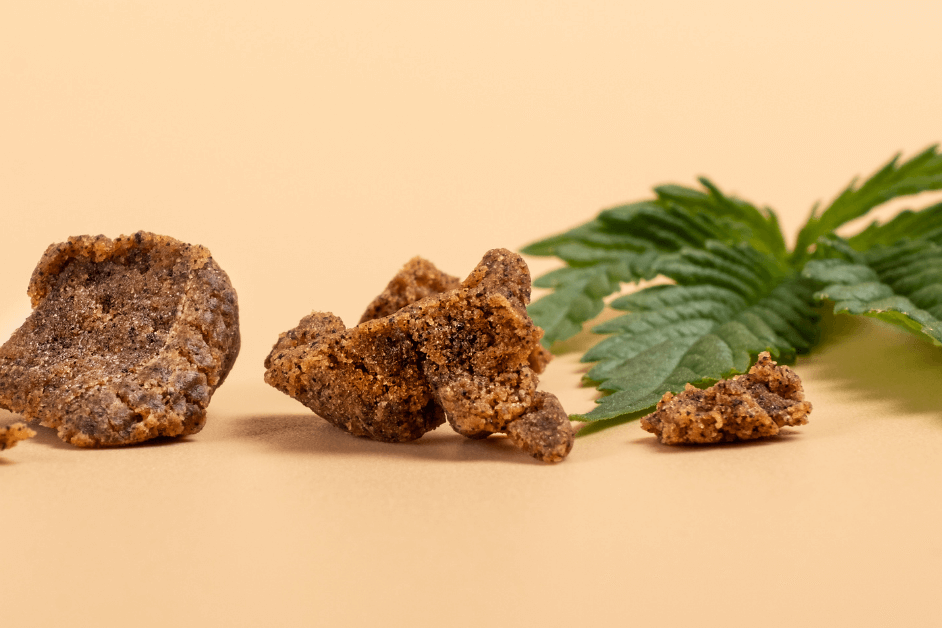Hash, also known as hashish, is a potent form of cannabis that is created by separating the resin-containing structures called trichomes from the marijuana plant material. In this article, we’ll tell you what is hash? And talk about everything you need to know about hashish in Canada, including its history, how it’s made, and the effects it can have on the user.
We’ll also explore the different forms of hash and how to use it safely and responsibly. Whether you’re a seasoned cannabis user or new to the world of hash, this article will provide valuable information on this unique and powerful substance. Without further ado, let’s dive in!
What is Hashish (aka Hash)?
As earlier mentioned, hashish, commonly known as hash, is a form of marijuana that is made by separating the trichomes (resinous glands containing cannabinoids) from the cannabis plant. Trichomes are tiny, hair-like structures that cover the surface of the cannabis plant and produce the majority of its cannabinoids and terpenes, which are the chemical compounds responsible for the plant’s unique flavours, aromas, and effects.
Hash can vary in colour, texture, and potency depending on the method of production. It can range from dark brown to black and can be soft and pliable or hard and crumbly. It is typically consumed by smoking or vaporizing.
When you smoke hash, its effects can range from relaxed and euphoric to sedated and psychoactive, depending on the strain and potency of the hash.
Where Does Hash Come From?
Hashish originated in the Middle East, specifically in countries such as Morocco, Lebanon, and Afghanistan. Traditional hash has been used for centuries for religious and medical marijuana purposes. The process of making hash is an ancient one, dating back to at least 900 AD.
The traditional method of making hash involves rubbing the dried flowers between the hands or using a mesh screen to collect the trichomes. The trichomes are typically pressed into a powdery resin and formed into a variety of shapes, such as bricks or balls. This type of hashish is known as “finger hash” or “hand-rubbed hash.”
In recent years, new methods of making hash have been developed, such as using ice water to separate the trichomes from the plant material. The ice water method is also known as the “bubble hash” or “dry ice method.” The trichomes are collected and pressed into a final product.
Hashish is now produced and consumed worldwide, with different regions having their own unique methods of hash production and consumption. The quality and hash potency can vary greatly depending on the type of cannabis buds it was made from (i.e. cannabis Indica or Cannabis Sativa), the method of production, and the skill of the person making it.

Different Types of Hash?
There are many different types of hash, and the specific type can vary based on the method of production and the specific strain of cannabis used.
Some common types of hash include:
- Dry-sieved hash: This is the most common type of hash and is made by using a screen or sieve to separate cannabis resin from the plant material. It is typically made by hand and can vary in colour, texture, and potency depending on the strain of cannabis used and the efficiency of the sieving process.
- Water-extracted hash: This type of hash is made by using dry ice water to extract the trichomes from the cannabis plant material. The trichomes are collected and then dried to form a soft, pliable hash.
- Solvent-extracted hash: This type of hash is made by using a solvent, such as alcohol or butane honey oil, to extract the trichomes from the plant material. The solvent is then purged to remove any residue, leaving a concentrated, potent form of hash.
- Bubble hash: This type of hash is made using a combination of ice water and agitation to separate the trichomes from the plant material. It is known for its high potency and smooth, buttery texture.
- Charas: This type of hash is made in India and is produced by hand-rolling live cannabis plants to collect the sticky resin trichomes. It is typically soft and pliable and has a strong, pungent aroma.
Benefits of Cannabis Hash
Marijuana use is believed to have a number of potential therapeutic benefits. Cannabis concentrates such as hash are ideal for recreational use, but some people also use them for medicinal purposes to help alleviate certain symptoms and conditions.
Some potential benefits of cannabis hash include the following:
- Pain relief: Cannabis hash is believed to have pain-relieving properties and may be effective in reducing chronic pain, muscle spasms, and inflammation.
- Stress and anxiety relief: Some people use cannabis hash to help reduce stress and anxiety. It is thought to have a calming effect on the mind and body and may help to relax the muscles and ease tension.
- Improved sleep: Cannabis hash is also believed to have sedative effects and may help to improve sleep. It may be particularly helpful for people with insomnia or other sleep disorders.
- Appetite stimulation: Cannabis hash is known to stimulate appetite and may be helpful for people with certain medical conditions that cause a lack of appetite.
- Nausea and vomiting relief: Cannabis hash may also help to reduce nausea and vomiting, making it useful for people undergoing chemotherapy or other treatments that cause these side effects.
How to Take Bubble Hash?
There are several ways to consume cannabis hash, including smoking, vaporizing, and ingesting it.
- Smoking: One of the most common ways to consume hash is by smoking it. It can be smoked on its own or mixed with tobacco or other herbs and smoked in a pipe or rolled into a joint.
- Vaporizing: Vaporizing is another popular way to consume hash. It involves heating the hash to a temperature that is high enough to vaporize the active compounds but not so high that it combusts and produces smoke. Vaporizing is thought to be a healthier alternative to smoking as it produces fewer harmful byproducts.
- Ingesting: Like other cannabis concentrates, hash can also be ingested, either on its own or mixed into food or drinks. It is important to note that ingested hash may take longer to take effect, and the effects may be more intense and longer-lasting than when it is smoked or vaporized.
Where to Buy Hash Online in Canada?
Buy hash online in Canada at WeedSmart. WeedSmart is a premium dispensary that provides users with access to high-quality cannabis products. From flower to pre-rolls and edibles, WeedSmart has it all. Enjoy cheap hash prices in Canada today.
Conclusion
Hash is a popular cannabis concentrate that’s made by compressing the trichomes, or the resin glands, of the marijuana plant. Hash typically has a higher THC content than marijuana flowers, which can result in heightened sensory perception and increased appetite.
However, it can also lead to distorted perception and withdrawal symptoms. Despite the recent legalization of marijuana in Canada, it is still illegal under federal law to produce or possess hash. Drug abuse and addiction are serious concerns associated with cannabis use, and those struggling with addiction should seek professional addiction treatment. It’s also important to note that hash contains other cannabinoids that can also have psychological effects.
As the legal and societal attitudes towards cannabis continue to evolve, it’s crucial that more research is done to fully understand the effects and potential risks associated with hash and other cannabis concentrates.
References
Wikipedia. Hashish. Available at: https://en.wikipedia.org/wiki/Hashish
Leafly. Learn Cannabis glossary T Trichomes. Available at: https://www.leafly.com/learn/cannabis-glossary/trichomes
Daily Marijuana. (2023, February 1). Buy Hash Online in Canada. Available at: https://dailymarijuana.io/shop/cannabis-concentrates/hash/
Get Kush. (2023, February 1). Best Online Hash Dispensary in Canada. Available at: https://getkush.cc/product-category/concentrates/hash/
NIH. National Library of Medicine. (July 4 20066) Role of the Cannabinoid System in Pain Control and Therapeutic Implications for the Management of Acute and Chronic Pain Episodes. Available at: https://www.ncbi.nlm.nih.gov/pmc/articles/PMC2430692/




